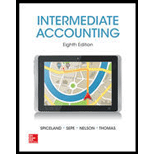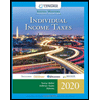
INTERMEDIATE ACCOUNTING
8th Edition
ISBN: 9780078025839
Author: J. David Spiceland
Publisher: McGraw-Hill Education
expand_more
expand_more
format_list_bulleted
Concept explainers
Question
Chapter 10, Problem 10.7E
To determine
Goodwill is an intangible asset. It is defined as the excess of cost of an acquired company over the fair value of its net assets. Net assets are the difference between the total assets and the total liabilities. The value of the goodwill is the unique features of the company such as the location of the company, its efficient employees, and its reputation, which cannot be associated with any specific asset of the Company.
To Calculate: The amount paid for the goodwill.
Expert Solution & Answer
Want to see the full answer?
Check out a sample textbook solution
Students have asked these similar questions
Given solution for General accounting question not use ai
I need the correct answer to this general accounting problem using the standard accounting approach.
Kindly help me with this General accounting questions not use chart gpt please fast given solution
Chapter 10 Solutions
INTERMEDIATE ACCOUNTING
Ch. 10 - Prob. 10.1QCh. 10 - Prob. 10.2QCh. 10 - Prob. 10.3QCh. 10 - Prob. 10.4QCh. 10 - Prob. 10.5QCh. 10 - Prob. 10.6QCh. 10 - When an asset is acquired and a note payable is...Ch. 10 - Explain how assets acquired in exchange for equity...Ch. 10 - Prob. 10.9QCh. 10 - Prob. 10.10Q
Ch. 10 - Prob. 10.11QCh. 10 - Identify the two exceptions to valuing property,...Ch. 10 - In what situations is interest capitalized?Ch. 10 - Define average accumulated expenditures and...Ch. 10 - Explain the difference between the specific...Ch. 10 - Prob. 10.16QCh. 10 - Prob. 10.17QCh. 10 - Explain the accounting treatment of costs incurred...Ch. 10 - Explain the difference in the accounting treatment...Ch. 10 - Prob. 10.20QCh. 10 - Prob. 10.21QCh. 10 - Prob. 10.22QCh. 10 - Prob. 10.23QCh. 10 - Acquisition cost; machine LO101 Beavert on Lumber...Ch. 10 - Prob. 10.2BECh. 10 - Prob. 10.3BECh. 10 - Cost of a natural resource; asset retirement...Ch. 10 - Asset retirement obligation LO101 Refer to the...Ch. 10 - Prob. 10.6BECh. 10 - Prob. 10.7BECh. 10 - Prob. 10.8BECh. 10 - Prob. 10.9BECh. 10 - Prob. 10.10BECh. 10 - Prob. 10.11BECh. 10 - Nonmonetary exchange LO106 Refer to the situation...Ch. 10 - Nonmonetary exchange LO106 Refer to the situation...Ch. 10 - Prob. 10.14BECh. 10 - Prob. 10.15BECh. 10 - Research and development LO108 Maxtor Technology...Ch. 10 - Prob. 10.1ECh. 10 - Acquisition cost; equipment LO101 Oaktree Company...Ch. 10 - Prob. 10.3ECh. 10 - Prob. 10.4ECh. 10 - Prob. 10.5ECh. 10 - Prob. 10.6ECh. 10 - Prob. 10.7ECh. 10 - Prob. 10.8ECh. 10 - Prob. 10.9ECh. 10 - Acquisition costs; noninterest-bearing note ...Ch. 10 - Prob. 10.11ECh. 10 - Prob. 10.12ECh. 10 - Prob. 10.13ECh. 10 - Prob. 10.14ECh. 10 - Prob. 10.15ECh. 10 - Prob. 10.16ECh. 10 - Nonmonetary exchange LO106 [This is a variation...Ch. 10 - Prob. 10.18ECh. 10 - Nonmonetary exchange LO106 [This is a variation...Ch. 10 - Prob. 10.20ECh. 10 - Prob. 10.21ECh. 10 - Prob. 10.22ECh. 10 - FASB codification research LO101, LO106, LO107,...Ch. 10 - Prob. 10.24ECh. 10 - Prob. 10.25ECh. 10 - Prob. 10.26ECh. 10 - Prob. 10.27ECh. 10 - Prob. 10.28ECh. 10 - Prob. 10.29ECh. 10 - Prob. 10.30ECh. 10 - Prob. 10.31ECh. 10 - Prob. 10.32ECh. 10 - Prob. 10.33ECh. 10 - Prob. 10.34ECh. 10 - Prob. 10.35ECh. 10 - Prob. 1CPACh. 10 - Prob. 2CPACh. 10 - Prob. 3CPACh. 10 - Prob. 4CPACh. 10 - Prob. 5CPACh. 10 - Prob. 6CPACh. 10 - Prob. 7CPACh. 10 - Prob. 8CPACh. 10 - Prob. 9CPACh. 10 - Prob. 10CPACh. 10 - Prob. 1CMACh. 10 - Prob. 2CMACh. 10 - Prob. 3CMACh. 10 - Prob. 10.1PCh. 10 - Prob. 10.2PCh. 10 - Prob. 10.3PCh. 10 - Prob. 10.4PCh. 10 - Acquisition costs; journal entries LO101, LO103,...Ch. 10 - Prob. 10.6PCh. 10 - Prob. 10.7PCh. 10 - Prob. 10.8PCh. 10 - Prob. 10.9PCh. 10 - Prob. 10.10PCh. 10 - Prob. 10.11PCh. 10 - Prob. 10.12PCh. 10 - Judgment Case 101 Acquisition costs LO101, LO103,...Ch. 10 - Prob. 10.2BYPCh. 10 - Judgment Case 10–3
Self-constructed...Ch. 10 - Judgment Case 104 Interest capitalization LO107...Ch. 10 - Prob. 10.6BYPCh. 10 - Prob. 10.7BYPCh. 10 - Judgment Case 108 Research and development LO108...Ch. 10 - Prob. 10.9BYPCh. 10 - Prob. 10.11BYPCh. 10 - Prob. 10.12BYPCh. 10 - Prob. 10.13BYPCh. 10 - Prob. 10.14BYPCh. 10 - Prob. 10.15BYPCh. 10 - Prob. 10.16BYPCh. 10 - Prob. 10.17BYP
Knowledge Booster
Learn more about
Need a deep-dive on the concept behind this application? Look no further. Learn more about this topic, accounting and related others by exploring similar questions and additional content below.Similar questions
- I am looking for the correct answer to this accounting question with appropriate explanations.arrow_forwardI am searching for the accurate solution to this financial accounting problem with the right approach.arrow_forwardI am looking for the correct answer to this general accounting problem using valid accounting standards.arrow_forward
- Hello tutor please given General accounting question answer do fast and properly explain all answerarrow_forwardChalmers Corporation operates in multiple areas of the globe, and relatively large price changes are common. Presently, the company sells 110,200 units for $50 per unit. The variable production costs are $20, and fixed costs amount to $2,079,500. Production engineers have advised management that they expect unit labor costs to rise by 10 percent and unit materials costs to rise by 15 percent in the coming year. Of the $20 variable costs, 25 percent are from labor and 50 percent are from materials. Variable overhead costs are expected to increase by 20 percent. Sales prices cannot increase more than 12 percent. It is also expected that fixed costs will rise by 10 percent as a result of increased taxes and other miscellaneous fixed charges. The company wishes to maintain the same level of profit in real dollar terms. It is expected that to accomplish this objective, profits must increase by 8 percent during the year. Required: Compute the volume in units and the dollar sales level…arrow_forwardAfter describing a threat/risk in either the revenue cycle (i.e., in sales and cash collection activities) or the expenditure cycle (i.e., in purchases or cash disbursement activities). What are specific internal controls that might be applied to mitigate each of the threats we've identified?arrow_forward
arrow_back_ios
SEE MORE QUESTIONS
arrow_forward_ios
Recommended textbooks for you
 Individual Income TaxesAccountingISBN:9780357109731Author:HoffmanPublisher:CENGAGE LEARNING - CONSIGNMENT
Individual Income TaxesAccountingISBN:9780357109731Author:HoffmanPublisher:CENGAGE LEARNING - CONSIGNMENT


Individual Income Taxes
Accounting
ISBN:9780357109731
Author:Hoffman
Publisher:CENGAGE LEARNING - CONSIGNMENT
